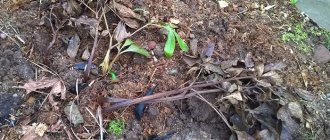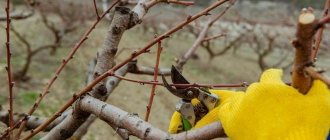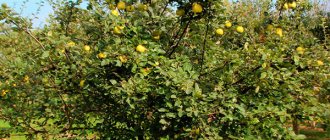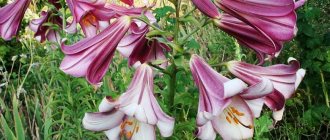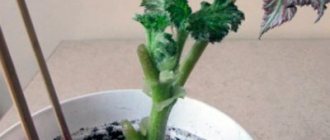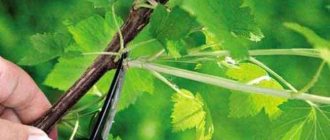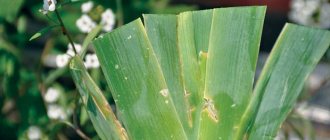Beautiful peonies grow in many gardens. These are one of the first perennials to bloom.
Dear readers! For you, we have created communities on social networks in which useful articles and interesting ideas are published several times a day! Subscribe and receive useful content in a convenient format!
Despite the fact that the flowering of the shrub ends in the first half of summer, caring for it in the fall is very important so that it blooms luxuriantly and abundantly in the next garden season.
In this article we will look at how to properly prepare a flower for a long winter.
What to do in the fall to prepare peonies for winter
Peonies, unlike many other beautifully flowering plants, are completely unpretentious in care. They are able to tolerate frost, drought and, conversely, an abundance of moisture.
However, unfavorable conditions negatively affect their decorative qualities. But these plants are grown precisely because of their beautiful flowering.
Therefore, in order for the shrub to delight you with lush flowering, it must be properly prepared for the upcoming cold weather. And this means providing appropriate care.
Preparation for wintering consists of the following agrotechnical measures:
- pruning immediately after the end of flowering (carried out in the summer, flower stalks are removed);
- introduction of nutritional compounds;
- pruning for winter;
- loosening the soil and weeding;
- mulching the soil under the bush;
- shelter for the winter.
REFERENCE. In the fall, you can replant the peony or propagate by dividing the rhizome.
Useful video
How to properly transplant peonies - video
Peonies have faded - what to do? flower growers' mistakes - video
Even with all the conditions of maintenance and care, namely watering, fertilizing, loosening, weeding, replanting, without proper pruning, peonies will not delight you with their beauty and fragrance. Only timely and much-needed pruning of flowers will prepare them for weather changes, strengthen the immune system, give strength and health for the formation of new buds and ensure lush, abundant and long-lasting flowering next season. A minimum of care and attention to your pets and they will definitely thank the flower growers and become the subject of their pride and admiration.
How to properly prune peonies in autumn
Leaves and stems are trimmed in late autumn, when the shoots have completely dried out and the leaves have fallen off.
ON A NOTE. Try to trim the stems as late as possible. Preferably after the temperature drops below zero for the first time.
The pruning time is October or November. It all depends on the specific region and the weather that year.
Pruning is very simple: with a sharp pruning shears you cut the shoots at soil level. You can leave a maximum of 2-5 cm.
Removed shoots must be removed from the site (in no case should these stems and leaves be used as covering material). Burn all greenery or throw it outside the garden.
Features of pruning tree peony
Tree peony pruning is carried out 2 times - before the start of the growing season (before the start of sap flow, in early spring) and in late autumn, after complete leaf fall. Radical cutting of the crop is contraindicated; it is recommended to remove only damaged shoots, shorten long ones.
Attention! When carrying out manipulations in the spring, difficulties often arise. An inexperienced gardener will not notice damaged shoots, so it is better to wait for the buds to swell.
If the tree-like format of the plant does not fit into the landscape of the site, you can form a bush culture. When pruning, the plant is left with several strong trunks, avoiding thickening. The buds of seedlings must be cut off for normal formation of the above-ground mass and active budding.
When to feed peonies in the fall
Over the entire summer season, the peony spends a lot of energy on growing shoots and especially on the formation of peduncles and inflorescences. During these months, the root system only consumes minerals and receives a minimal amount of nutrition.
In autumn, the growth of green mass is not needed, so you can provide the necessary care to the roots.
You can feed the bush in preparation for winter from late August to mid-autumn. The specific date depends on the weather at that time of year and on the region (the further south, the later).
At this time of year, potassium-phosphorus mineral supplements are used. You can use both liquid formulations and granular fertilizer.
Fertilizer in granular form is scattered under the bush if the autumn turns out to be rainy.
If autumn is dry, then it is better to use liquid formulations.
For 1 adult bush, 40 grams of potassium sulfate and superphosphate are usually consumed.
Wood ash, chopped green manure tops or compost are suitable organic fertilizers for feeding peonies. Organic matter is added about a month before the onset of cold weather.
Autumn rules for caring for peonies
Spring and summer care includes: regular watering, loosening the soil in the root zone, killing weeds and removing buds that finish flowering. And caring for peonies in the fall involves pruning the bush, feeding it, and covering it during the cold season. To ensure that shrubs survive severe frosts, perform the following actions:
- Feed bushes that are blooming.
- If necessary, transplant some shrubs to a new location.
- They trim the bushes.
- Cover the soil with mulch.
The list of these activities is necessary to prepare the plant for winter. You don’t need to do anything unique; these universal actions are enough.
Autumn processing of peonies
Peony suffers not only from fungal and bacterial diseases. It is often attacked by ants and aphids. Thrips and spider mites are found a little less frequently, but still occur.
Therefore, an important stage in preparation for wintering is treatment against diseases and pests.
Spraying is best done 1-2 weeks before the pruning procedure. You can use any of the insecticides. Karbofos, Aktara, and Iskra have proven themselves well.
After pruning, re-treat with an insecticide. They spray not only the bush itself, but also the soil underneath it. Such care is needed to destroy those pests that overwinter at the roots of the flower.
Spraying against diseases can be done a little later. It is best to use modern copper-based preparations - Hom, Oxychom, etc. It is necessary to treat not only the shoots, but also the soil under the flower.
The working solution is prepared in accordance with the manufacturer's instructions.
When to prune peonies after flowering in autumn for winter
To prune peonies in the fall, it is important to determine the timing of this procedure. If you trim at the wrong time, the plant can be harmed. When planning a procedure, you must proceed from two rules:
- Plants should not be pruned too early (August, September, first half of October). During this period, the root system of peonies is actively growing, so they need nutrients that are formed in the tissues of the leaves and stems.
- Late pruning (from mid-November) is also harmful. At this moment, frosts occur in all regions, which can have a bad effect on exposed sections. The plant needs time to prepare for the dormant period.
Attention! The optimal time for pruning peonies in the fall is the second half of October and the beginning of November.
Although the timing may increase by 1–2 weeks depending on the climatic conditions of the region, as well as on the specific variety of flower. The main criterion for pruning is the onset of the first frost, when the temperature at night drops below zero.
Read more Milky-flowering herbaceous peony variety Sorbet (Sorbet)
You can remove shoots with pruning shears or a sharp knife.
When to prune peonies in the fall in the middle zone
In the regions of the middle zone, peonies should be cut in the fall in early November. By this point, negative temperatures are established not only at night, but also during the day. It is optimal for several frosts to pass, after which you can begin to work. In the south, the deadline shifts to mid-November, and in the northern, Ural and Siberian regions, on the contrary, to the end of October.
Attention! Sometimes the peony begins to dry out even before the cold snaps due to exposure to pests, fungal or bacterial diseases.
Then it is urgent to save the plant. Therefore, pruning is carried out immediately, without waiting for frost. All affected parts are removed and burned, and the bush is treated with fungicides, insecticides or folk remedies.
How to loosen and mulch peonies?
After pruning and treating with fungicides, the next stage of preparing peonies for winter begins - loosening and weeding.
Loosening is necessary so that the roots of the flower receive the required amount of air.
The procedure must be carried out very, very carefully so as not to damage the roots and buds of renewal. Depth - only 2-3 cm.
It is necessary to remove weeds so that they do not take root over the winter and deprive the peony of nutrients.
After this, the ground under the peony is mulched. This way you will prevent infection by pathogenic microorganisms. In addition, mulch is good for soil structure and retains moisture well.
Gardening tips
- After dividing the root part and replanting, it is not recommended to water the plants abundantly in the next few months. A young plant absorbs moisture too quickly and, if there is too much of it, the root part will begin to rot.
- After dividing an adult bush into parts, it is not recommended to plant plants in the same area. High-quality development of young crops - divisions - is possible only in a new flower garden or flower bed.
- Peonies love water very much and in large quantities, but absolutely cannot tolerate wet or waterlogged soil. To prevent water from stagnating, before planting it is necessary to fill the planting hole with reliable drainage material.
- Planting depth is of great importance for the growth and development of peony. Insufficient depth can lead to the fact that after numerous loosening of the tree trunk space and weeding of weeds, the buds and part of the rhizome will end up very close to the soil surface. Additional hilling can save such bushes. Planting too deeply will result in no flowering.
- Renewal buds when planting peonies should not be deeper in the ground than five to seven centimeters.
- To plant peonies on your site, it is recommended to use only young plants - seedlings. Massive, overgrown and old crops will become completely old in a couple of years and stop blooming. All the hassle of planting and care will be in vain.
- Without special need, you should not disturb peonies with frequent transplants.
- A root damaged during transplantation must be disinfected with a solution of copper sulfate, manganese solution, or sprinkled with crushed activated carbon.
- Early pruning of peony foliage (immediately after flowering) will cause irreparable harm to the crops. The next flowering will be sparse or may not occur at all.
Do I need to cover peonies for the winter?
Peonies are not as capricious a crop as, for example, roses. But they should also be covered for the winter. Especially when it comes to regions with cold climates.
But at this stage of preparation for winter you need to be very careful. Too large a layer of cover can cause the flower to dry out.
The peony is covered just a little. For example, a small layer of sawdust or peat. You can use spruce branches or dry grass.
Basically, shelter is required by those specimens that were planted in a bad place (blown by winds, snow does not accumulate, etc.).
The only thing is, do not leave peonies under the snow. Therefore, if there are thaws in winter, then all care will consist of periodically covering the bush with snow.
IMPORTANT! When preparing for the season, do not forget to remove the cover in early spring so that the flowers do not dry out.
Trimming technology
Stems with dried flowers should not be cut off completely, but leaving 2-3 leaves on the shoot. Remove the remaining part along with the rest of the shoots. It is important to consider the type of peony - herbaceous or tree-like. Pruning before winter must be done correctly, taking into account agrotechnical recommendations and varietal characteristics.
- preparation of instruments;
- removing branches;
- cleaning and burning of plant residues;
- fertilizing;
- insulation before winter.
Garden tools must be treated before use so that pathogenic infections from other crops do not penetrate through the cut sites. Simply wash and wipe with alcohol.
The remote above-ground part of peonies is a carrier of pathogens and can also serve as a home for rodents and insect larvae. For this reason, it cannot be used to insulate the root system before winter or added to compost. Cut branches must be removed from the site, dried and burned.
As fertilizers, use mineral complexes containing phosphorus and potassium, which are required for the development of roots. Nitrogen cannot be added, as it causes active growth of the above-ground part. Compost and rotted humus can be added closer to frost, because they are nitrogen-containing additives. Peonies love bone meal; when preparing for winter, you can add 1 cup to each bush. Wood ash is used as a fertilizer, a protective agent against diseases, and must be sprinkled on the surface of the earth and cuttings. Autumn feeding will make it easier to bear pruning and promote renewal of the root system.
Peonies are frost-resistant plants that can withstand frosts down to -15...-34 °C. At the same time, experienced gardeners recommend insulating bushes in regions with cold winters, as well as in the absence of snow. After trimming herbaceous varieties, you can add a layer of peat, sawdust, compost or cover with spruce branches. For tree-like ones, you will have to cover the soil surface with peat, build a hut from pine branches on the remaining shoots, and wrap them with twine. To protect from moisture, cover with film, leaving air vents. Hybrids are most susceptible to freezing.
Herbaceous
The branches of these varieties of peonies should be cut almost to the root. It is permissible to leave stumps 1-2 cm high, but no more. The instrument must be sharp, pre-disinfected, and free of soil and other plant residues. An infection can enter the bush through the cut site, which will lead to its death.
After pruning before winter, sprinkle fertilizers over the surface of the soil and loosen them, mixing the additive with the top layer of soil. It is allowed to sprinkle the resulting hemp with soil and mulch. The main thing is not to forget to remove excess cover in the spring.
Tree-like
Beginning gardeners sometimes prune peonies too much, removing skeletal branches. This cannot be done, since the first two years after this there will be no flowering. Tree varieties are formed or rejuvenated before winter. To give it a decorative shape, it is allowed to leave stems 70-90 cm high. In spring, many new shoots will appear. The second type of pruning can be carried out no more than once every 10 years. The need for it is noticeable by the deterioration of growth and flowering.
The technology for pruning tree peonies must not be violated. In normal preparation before winter, the woody skeleton should be left, removing only the leaves.
In the spring the procedure is repeated. This time, shoots without buds, dried, broken branches are cut off. For the purpose of rejuvenation, all healthy stems are shortened to the first bud.
Peonies need to be prepared for winter. Pruning is carried out in the fall in accordance with the varietal characteristics of the plant. It is important to disinfect working tools; after the procedure, the bushes should be fed and protected from frost. Cut branches cannot be used as insulation.
At the beginning of summer, peonies are considered one of the most remarkable and vibrant flowers in the garden. Spectacular lush buds of different shades, a unique fresh aroma and lush greenery outshine most of the neighbors in the flower garden for the entire flowering period. Such beauty is possible only with a competent integrated approach to growing garden plants.
A responsible attitude towards nature and proper care is the key to the full development of flower crops. One of the mandatory care items is pruning peonies. The quality and duration of future flowering depends on its competent and timely implementation.
It is recommended to prune both herbaceous and tree-like varieties of peonies three times a season - in early spring, after flowering and before winter. Each of these procedures has its own goals, which ultimately lead to one thing - to strengthening the health of peonies and its longevity.
What you need to do in the fall to get lush peonies blooming in the spring
In order for the shrub to bloom magnificently in spring and summer, it is necessary to carry out appropriate preparation in the fall. Properly performed standard agrotechnical care measures will help.
- Timely feeding. If autumn is dry, then use liquid preparations. If it rains regularly, then granular formulations can be used.
- Rejuvenation, transplantation, reproduction. Old bushes often degenerate, so it is advisable to renew them periodically. Autumn is the best time to transplant and propagate peonies. Over the winter, the seedlings will take root and begin to bloom in the new season.
- Trimming. Once the flowers fall, the stems will no longer be needed. As soon as they dry out, they must be cut off so that they do not become a source of infection and do not freeze in the winter.
- Treatment for diseases and parasites. Fungi and pests have a depressing effect on the flower. Autumn is the best time to get rid of uninvited guests.
Do I need to prune peonies after flowering in the fall?
Autumn pruning of peonies in winter is carried out annually, regardless of the type and variety of the flower. This must be done for several reasons:
- To stimulate the growth of new shoots next spring. This is especially important for mature bushes (anti-aging pruning). Often, for this purpose, all branches are completely shortened, leaving stubs of 4–5 cm (radical pruning).
- For prevention. Pest spores often overwinter in stems and old foliage (sanitary pruning of peonies).
- Giving the bush the correct contours (formative pruning).
Haircuts are carried out every year - both in spring and autumn. This is one of the basic rules for caring for peonies and many garden flowers.
